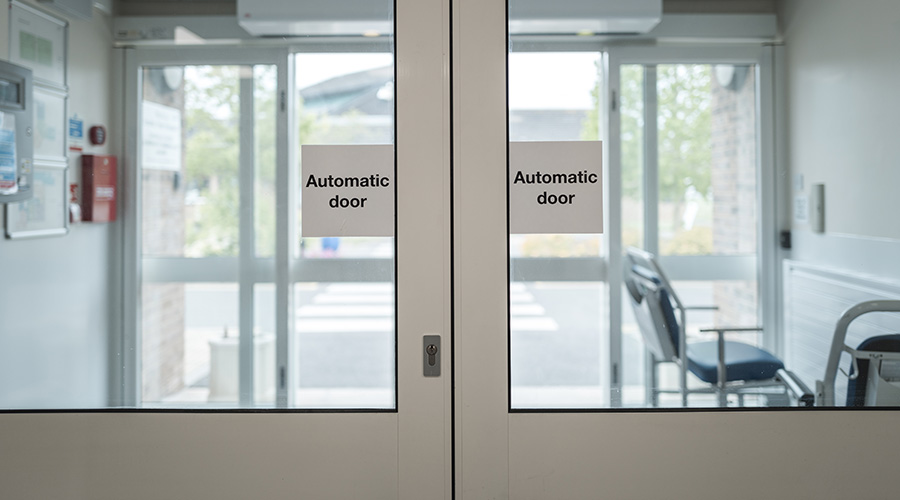Door Hardware: Finding the Key to Security
By David R. Duda and John E. Tokaji
With constant news of terrorism and workplace and school violence, it comes as no surprise that security is in people’s thoughts more than ever. The most basic form of security is the building that provides shelter and protects occupants.
Doors are vital parts of the physical structure, but they can either be the weakest link or provide formidable protection. A door is only as strong as the hardware that attaches and secures it to the frame.
Of all of the components of a security system, door hardware probably has the greatest impact on daily maintenance, reliability and longevity of a security system. So managers must pay close attention when specifying these components and overseeing their installation and maintenance.
The Electronic Age
Many access control systems in commercial, institutional and government buildings are now reader- and computer-based. These systems have come down in cost, and most are now network-based. Readers transmit signals or data to processor-based field panels, where access decisions are made. They can be magnetic stripe, proximity, smart card, or biometric readers, or some combination of these.
The door hardware will become long-term problems for most maintenance and engineering departments. Whether keypads, card readers or biometric devices control the doors, the hardware will keep the maintenance staff busy.
Door Contacts
Door-position sensors — contacts — are mounted onto or in the header or frame, and they accomplish multiple functions. They indicate the status of the door to security personnel, and they interact with the other security components of the door via the access-control system control logic to immediately re-energize the lock once the door has opened to ensure it is secure upon closing.
Functionally, they are either mechanical switches or magnetic reed switches, with the latter considered more reliable. A magnetic contact switch has two components. The magnetically operable switch is housed in a glass tube sealed in a plastic or metal housing. This assembly gets mounted in the header or frame. When the magnet gets within a specific distance of the switch, the magnetic field closes the switch, completing the circuit.
Recessed contacts resist tampering and are far more attractive than their surface-mounted counterparts. But if not installed properly, they can work their way out of the cavity, eventually to be sheared off by a closing door.
Careless users can knock off surface-mounted switches, so managers should make sure these switches match the application and that technicians install them on the secure side of the door.
Manufacturers also make locking hardware with built-in door contacts or switches. These switches generally do not have the 4- to 6-inch range of their standalone counterparts, resulting in more false alarms. Mechanical ball-type switches are maintenance headaches, and managers should avoid them unless special circumstances require their use.
A new type of door switch actually is part of the hinge and operates on the same reed principle. Its applications are limited because not all types of hinges have this option.
They also might not be as secure as their header-mounted counterparts. The door must be opened further for the circuit to open. Security personnel generally would like to see a switch circuit open if the door is opened 4-6 inches.
Hinges
Where an electrically operated mechanism is actually integral to the door itself, power must transfer from the frame to the door. Specifiers can accomplish this requirement by using either an electric hinge or a power-transfer device.
A power door cord also is an alternative, but it can be unsightly. These are essentially flexible metallic cords with wiring that attach to the frame on one end and the door on the other end.
Power-transfer devices tend to be the most reliable, since they generally don’t support the door’s weight, have more substantial enclosures, and use larger-gauge wire.
Locksets
Locksets and mortise locks come in mechanical and electromechanical versions. Some of the more advanced control schemes use electromechanical versions, especially where managers want electronic keypads, card readers or biometric devices to control access to the building.
When equipped with a built-in or plug-in, full-wave bridge rectifier, the devices operate on both AC and DC power. Most devices operate at 12 volts or 24 volts, but a few require 120 volt. Locksets are equipped with an electric solenoid that retracts or extends the bolt. Managers can specify many of these devices to be field changeable from fail safe to fail secure, or visa-versa.
Mortise locks provide exceptional mechanical stability. They are rated for use in all doors, including up to three-hour fire-rated assemblies, and they can be field handed, or converted for use on right-or left-hand doors.
Electric Strikes
Electric strikes release the barrier or binding plate to allow the lock bolt to swing past the keeper. Electric strikes also can be rated for use in all doors, including up to 3-hour fire-rated assemblies, and they also can be field handed.
Some code authorities do not allow electric strikes where doors must latch in place to prevent the spread of smoke or fire. Generally, they are noisy in operation, resulting in a loud snap upon the door opening and the keeper returning to its normal state — a bad idea for quiet environments where noise can cause a distraction.
Magnetic Locks
The magnetic lock, or maglock, is probably one of the most misapplied door-hardware components available because they contain virtually no moving parts and are maintenance friendly. They also are probably the least secure component in the family of security locking hardware products.
Magnetic locks fail open. In the event of either a power failure or fire alarm, they leave the door unsecure. In trying to prevent this, some technicians have inadvertently violated local life safety codes by attaching a battery backup or uninterruptible power supply.
NFPA 101 requires doors with magnetic locks to have a motion detector installed on the secure side of the door configured to release power to the lock upon approach. But with this set-up, someone walking by the secure side of the door can inadvertently release it.
Magnetic locks also produce a loud slapping sound upon closing, which is undesirable in quiet environments.
These locks do have their place, and properly configured, managers can specify them for use along with panic hardware equipped with an integral switch in a delay or non-delay mode. Managers considering them should seek the advice of the authority that has jurisdiction.
Exit Devices
These devices, also called crash bars, typically are found on doors in the path of egress. This panic hardware is designed for easy release in extreme situations, including low visibility, smoke and fire. Crash bars with built-in switches can be configured to release electric mortise locks, specific strikes, or vertical rods in the case of a double door.
Vertical rods are moving rods that are mechanically linked to the crash bar and extend into the door frame on the top or bottom of the door. With so many moving parts, they often require maintenance and can sustain damage from heavy use.
Managers must use them carefully and be sure to use the appropriate release mechanism. Vertical rods also can be very loud, both in the release or relocking cycle.
It is often more practical to mechanically latch the inactive side of a double-door exit with vertical rods and use a panic bar with an electric mortise lock for the side that would be used for access control. This set-up will meet exit requirements and eliminate the maintenance headache.
Managers also must choose between concealed and surface-mounted hardware. Concealed rods are less susceptible to damage, but they require removal of the door for service or replacement. Surface-mounted rods are easier to work on, but objects pushed into them can damage them. Using surface-mounted rods with protective covers often is a good compromise.
Finally, closers are a common source of maintenance problems, so managers should be certain to match the specific closer to the type of door it must close.
Hardware Options
Keyless entry systems are available in standalone, microprocessor-based, battery-powered electrical locksets. Typically equipped with a 4- to 12-button keypad and standard builder’s cylinder, the units can store dozens to hundreds of codes.
While an administrator can easily add or delete user codes right at the keypad, large numbers of these devices can be difficult to manage, or if more than a few dozen people use them.
With the availability of 1 gigabyte jump drives that are smaller than a pocket knife, managers can get both keys and locks with small microprocessors built-in.
One high-tech option is to use an intelligent key and lock system. These systems use battery-powered intelligent keys that are programmable to only unlock specific doors on specific days at specific times. The battery in the key powers the lock, so they require no wiring.
Intelligent lock cylinders often can replace mechanical cylinders in existing locking hardware, making retrofits comparatively inexpensive. These locking devices include mortise locks, panic devices, deadbolts and key switches.
Managers can program keys with a start date and issue them before they begin working. Keys also can be set to expire at a specific time. The lock and key each store a record of the key’s use. Technicians can download this data, where application software can create audit reports showing the trail of the key holder or holders that accessed a specific lock.
Finally, biometric fingerprint locks provide impressive protection, convenience and speed if a small number of individuals need access through the door. Readers are one of the most accepted, economical authentication systems. To access the system, enrolled users must be physically authenticated. So no one can breach its security except its enrolled users.
Balancing security needs with operational needs remains challenging. But managers armed with up-to-date information stand a better chance of securing facilities while lessening the ongoing headaches that hardware maintenance can create.
David R. Duda, P.E., CPP, PSP, CSC, LEED-AP, is an associate partner with Newcomb & Boyd, an Atlanta-based consulting engineering firm. His experience includes the design of special- low-voltage systems, including security, closed circuit television, intercom, and communications systems. John E. Tokaji, PSP, is a senior associate with Newcomb & Boyd and is a security engineer. His background includes working with both public- and private-sector clients.
Browse Door Hardware Prodcuts
Related Topics:











